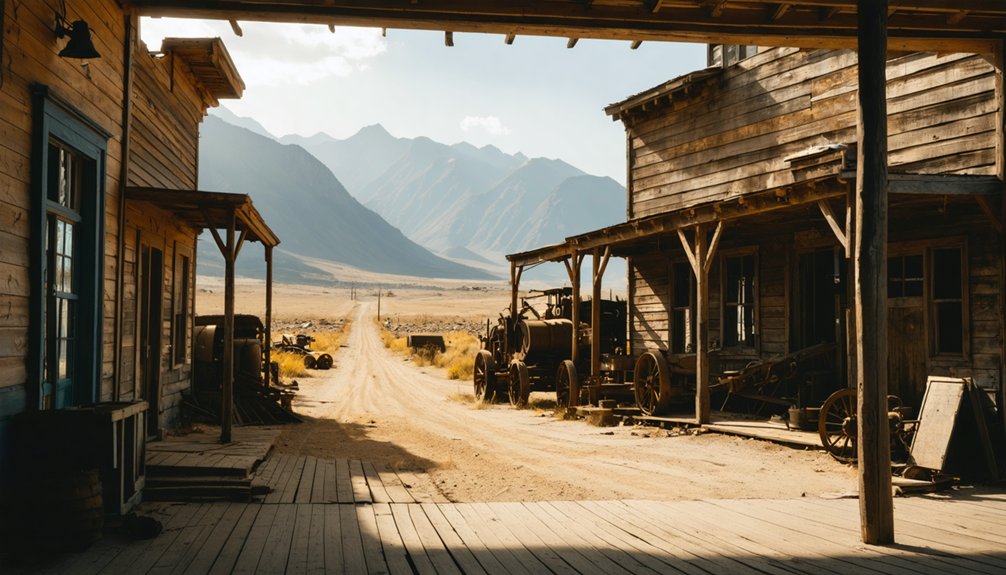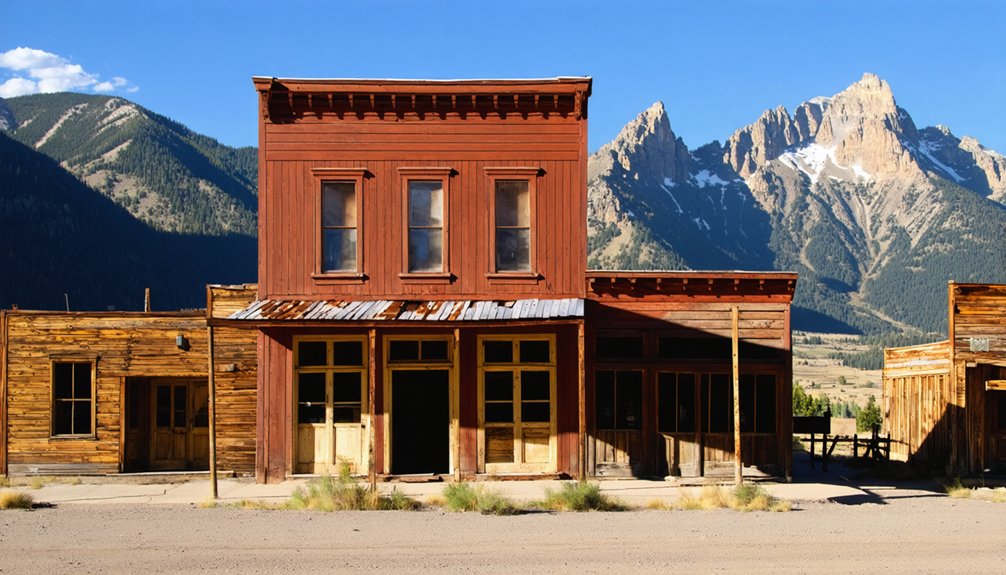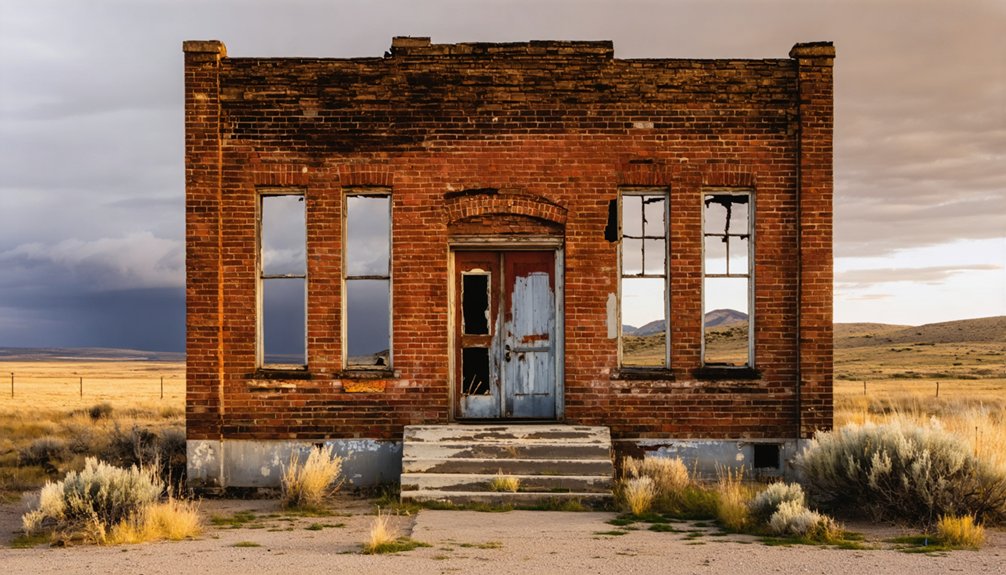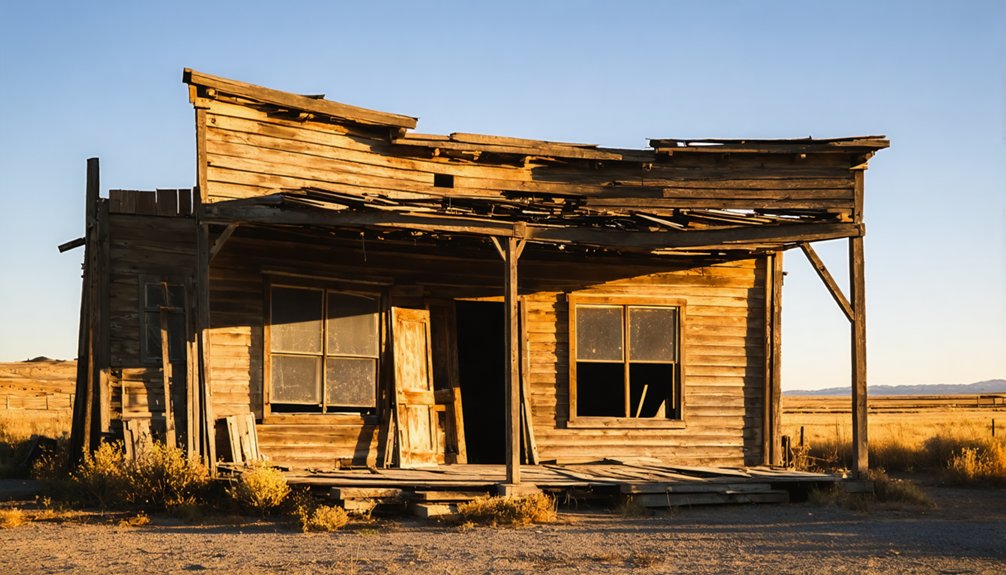You’ll find Custer ghost town nestled in Idaho’s Salmon-Challis National Forest, where an 1867 gold discovery sparked a mining boom that lasted until 1904. At its peak in 1896, this frontier town bustled with 600 residents, eight saloons, and major mining operations like the General Custer and Lucky Boy mines. Today, you can explore well-preserved structures, including the Empire Saloon and schoolhouse, that tell the story of Idaho’s wild mining era.
Key Takeaways
- Custer is a preserved ghost town in Idaho’s Yankee Fork area, established in 1867 following gold discovery and listed on National Register of Historic Places.
- The town peaked with 600 residents in 1896, thriving on silver-gold mining before declining when major mines closed by 1904.
- Visitors can explore restored 19th-century structures including the Empire Saloon and schoolhouse within Land of the Yankee Fork State Park.
- The mining district produced 329,586 ounces of gold by 1959, with the Lucky Boy Gold Mining Company generating $1 million.
- The site is maintained by preservation groups, with guided tours available during summer months through Friends of Custer Museum volunteers.
The Birth of a Mining Frontier
When gold was discovered in Idaho’s Yankee Fork area in 1867, it sparked the beginning of what would become the bustling mining town of Custer. The early years saw small-scale operations, but by 1875, lode mining transformed the region as prospectors targeted rich silver-gold veins in the area’s dolomitic limestone.
The town reached its peak with a population of 600 in 1896 as mining operations flourished. You’ll find that mining technology advanced rapidly after George Hearst’s investment in the General Custer Mining Company. By 1880, they’d built a state-of-the-art steam-powered 20-stamp mill and a 3,200-foot aerial tram, revolutionizing ore processing and transport.
These developments created significant economic impacts throughout the region. The town of Custer, established in 1878, quickly outgrew its neighbor Bonanza, becoming the district’s primary settlement. Major mines like General Custer, Lucky Boy, and Fourth of July drove the area’s explosive growth. The town’s reputation grew wilder as it supported eight saloons during its peak years.
Gold Rush Glory Days
While Custer’s early mining activities showed promise, the town’s true golden age emerged in 1895 when the Lucky Boy Gold Mining Company acquired the General Custer Mine and mill.
As you explore this period of Idaho’s gold rush history, you’ll discover a booming frontier town that employed 130 men and generated an impressive $1 million before its 1904 closure.
The mine was part of the Yankee Fork District which operated between lat 4420 and 4430 N. and long 11440 and 11450 W. in northwestern Custer County.
Today, visitors can explore the original buildings that line the half-mile main street.
You can picture the town’s wild spirit through these defining features:
- Eight bustling saloons serving the 600 residents
- Modern stamp mill technology crushing gold-bearing ore
- A newly constructed toll road connecting to Challis
- Essential establishments like the post office and school
The Yankee Fork district’s success made it one of Idaho’s top gold camps, with production reaching 329,586 ounces of gold by 1959, cementing Custer’s place in mining history.
Life in a Wild West Boomtown
Life in Custer transformed from a rugged mining camp into a vibrant boomtown following the 1879 founding. You’d have found yourself among 600 residents at its peak in 1896, maneuvering a frontier mining community filled with saloons, restaurants, and a bustling post office.
The Lucky Boy mines employed 130 men, while the General Custer Mill kept the town’s economy humming. The dangerous work in the mines often led to high injury rates. After a devastating grass fire destroyed nearby Bonanza, Custer saw a surge of new residents seeking opportunity.
As you’d walk down the streets, you’d encounter a diverse population, including Chinese immigrants who established their own thriving Chinatown. Despite frontier challenges like harsh winters and avalanches, the community proved remarkably resilient.
You could’ve enjoyed entertainment at the dance hall, conducted business at various shops, or visited one of five saloons. While law enforcement struggled with the infamous “Custer crime wave,” the town maintained essential services like schools and blacksmith shops.
The Inevitable Decline
Despite its early success as a bustling mining hub, Custer’s decline began in earnest with the closure of the General Custer Mining Company in 1888.
You’ll find that economic vulnerabilities quickly surfaced as major mines exhausted their gold veins, leading to widespread closures by 1904.
The town’s social dynamics shifted dramatically as families moved away, leaving only 12 households by 1910.
- Picture empty saloons where miners once celebrated their daily finds
- Envision abandoned mine shafts scattered across the mountainside
- See weathered wooden structures buckling under harsh Idaho winters
- Imagine empty streets where 600 people once bustled about
Nature’s challenges, including avalanches and grass fires, coupled with the town’s remote location at 6,470 feet, made it increasingly difficult to sustain life in this once-thriving community. Visitors today should plan their visits carefully according to seasonal weather conditions to safely explore this historic site.
Preservation Efforts and Historical Status
Since its placement on the National Register of Historic Places in 1981, Custer has emerged as a pioneering example of mining camp preservation in America. The Challis National Forest‘s acquisition of the site in 1966 marked the beginning of concentrated preservation efforts, ensuring this remarkable piece of Idaho’s mining heritage wouldn’t be lost to time.
You’ll find several meticulously restored structures that showcase the town’s historical significance, including the Empire Saloon and the schoolhouse. These buildings represent rare examples of 19th-century mining camp architecture, offering you a genuine glimpse into frontier life. The Lucky Boy Mine was a major contributor to the town’s peak population of 600 residents in 1896.
During summer months, dedicated volunteers from Friends of Custer Museum bring the town’s story to life, providing detailed historical information as you explore the grounds. The town’s arid climate has helped preserve many original structures in remarkable condition. As part of the Land of the Yankee Fork State Park, Custer’s architectural preservation efforts continue to protect this invaluable cultural resource.
Planning Your Visit Today
To reach Custer Ghost Town safely, you’ll need to turn off Highway 75 at Sunbeam and follow a 9-mile gravel road, which is manageable even without a high-clearance vehicle.
You should pack plenty of water and food for your visit since potable water isn’t available on-site, and refreshments are limited to what’s offered at the Empire Saloon.
Remember to bring a camera, comfortable walking shoes, and weather-appropriate clothing, as mountain conditions can change quickly in the Sawtooth National Recreation Area. During summer months, you can join guided tours available to learn about the town’s mining history.
Getting There Safely
While getting to Custer ghost town requires careful planning, the journey can be safely made by following a few key preparations.
Road conditions vary seasonally, with summer offering the most reliable access via the gravel road from Highway 75. You’ll want to guarantee your vehicle meets basic requirements before departing from either Stanley or Challis.
- Download offline maps and save GPS coordinates (44°23′15″N 114°41′45″W), as cell service doesn’t exist in the area.
- Fill your gas tank and pack emergency supplies, including a spare tire and basic repair kit.
- Choose your route based on your vehicle’s capabilities – standard cars can handle the main road, while the scenic Motorway needs high clearance.
- Check weather forecasts and road conditions at local visitor centers, as conditions can change rapidly.
What To Bring
Once you’ve mapped out your route to Custer ghost town, preparing the right supplies and gear becomes your next priority. Your packing essentials should include plenty of water, as there’s no potable drinking water onsite, plus snacks or a packed lunch.
Bring a daypack to carry these items along with a first-aid kit and camera.
Weather considerations are essential at this elevation. Pack layers of light, breathable clothing that you can adjust throughout the day, and don’t forget a weatherproof jacket for unexpected mountain storms.
You’ll need a wide-brimmed hat, sunglasses, and sunscreen for protection against intense UV rays. Wear sturdy hiking shoes for exploring uneven terrain, and consider bringing trekking poles for extra stability.
Remember cash for purchases and a detailed map for self-guided tours when rangers aren’t available.
Legacy of the Last Mining Stand

When you explore Custer’s preserved buildings today, you’ll find tangible evidence of Idaho’s dramatic mining saga that saw this remote mountain town rise and fall within a single generation.
The town’s explosive growth in the 1880s, fueled by gold and silver discoveries worth millions, gave way to a swift decline as mines played out by 1904, leaving only a dozen families by 1910.
Through careful preservation efforts since the 1960s, Custer’s historic structures – from the Empire Saloon to the miners’ union hall – now stand as silent witnesses to the boom-and-bust cycle that shaped America’s western frontier.
Mining’s Boom and Bust
As the General Custer Mining Company established operations in 1878, Custer’s first major mining boom transformed the remote Idaho landscape into a bustling frontier settlement.
You’ll find a tale of economic fluctuations and social volatility that defined this mining town’s dramatic story.
- By 1879, you’d have seen the General Custer Mill rising alongside a growing town, marking the start of industrial-scale mining.
- After the company’s closure in 1888, you’d witness the town’s first major bust.
- In 1895, you’d experience renewed hope as Lucky Boy Mining Company revived operations.
- During 1896-1898, you’d find yourself amid eight saloons and 130 workers during the second boom.
Each cycle brought waves of prosperity and decline, from the initial gold rush through the mid-20th century’s $47 million production era, shaping Custer’s destiny as a true frontier boomtown.
Preserving Western Heritage
Through decades of dedicated preservation efforts, Custer’s remarkable mining heritage stands protected for future generations to explore. Since 1999, organizations like the South Custer Historical Society have worked tirelessly to conserve this slice of Western history.
You’ll find their cultural preservation work evident in the stabilized Shay trestle, tramway towers, and historic cabins that dot the landscape.
The site’s historical significance earned it a spot on the National Register of Historic Places in 1981.
Today, you can join volunteer-led summer tours through preserved saloons, schoolhouses, and mining structures that tell the story of frontier life. The ghost town serves as both an outdoor museum and active archaeological site, where you’ll discover how these pioneering communities thrived in Idaho’s remote mining districts.
Frequently Asked Questions
What Happened to the Original Buildings That No Longer Exist?
You’ll find that many original structures deteriorated from neglect, burned in fires, collapsed from harsh winters, or were demolished during historical preservation efforts. Some were also moved or dismantled entirely.
Were There Any Famous Outlaws or Notable Incidents During the Crime Wave?
You’d be disappointed searching for notable criminals in Custer’s history – there weren’t any famous outlaws or significant crime incidents. The town dealt with typical frontier challenges rather than dramatic criminal activity.
How Did Residents Get Supplies During Harsh Idaho Winters?
You’d rely on mule-drawn sledges hauling supplies through treacherous supply routes, while stockpiling essentials before winter. When snow trapped you, winter survival meant sharing resources and preserved food with fellow residents.
What Native American Tribes Inhabited the Area Before Mining Began?
You’ll find the Nez Perce inhabited the north-central region, while the Shoshone-Bannock tribes dominated southern Idaho. These native tribes held historical significance through their established settlements, hunting grounds, and cultural practices.
Did Any Wealthy Mine Owners Maintain Permanent Residences in Custer?
While wealthy residents made fortunes from mining impact, you won’t find records of mine owners keeping permanent homes in Custer – they typically managed their investments from afar rather than settling there.
References
- http://www.fs.usda.gov/r04/salmon-challis/recreation/discover-history/custer-ghost-town
- https://www.legendsofamerica.com/id-bonanzacuster/
- https://www.wanderingidahoan.com/adventures/custer-city-ghost-town
- https://history.idaho.gov/wp-content/uploads/2018/09/Custer_Historic_District_81000207.pdf
- https://www.atlasobscura.com/places/custer-ghost-town
- https://en.wikipedia.org/wiki/Custer
- https://westernmininghistory.com/towns/idaho/custer/
- https://yankeeforkdredge.com/local-attractions/
- https://westernmininghistory.com/library/38225/page1/
- https://npshistory.com/publications/nhl/theme-studies/mining-frontier.pdf



